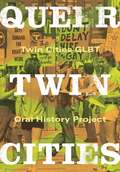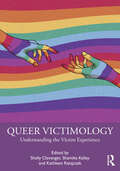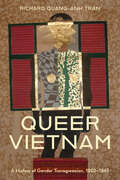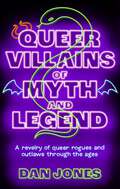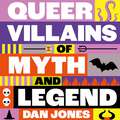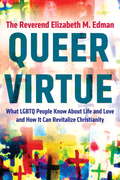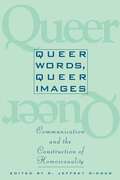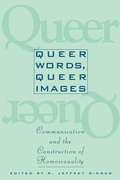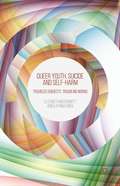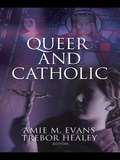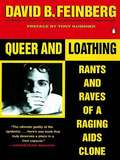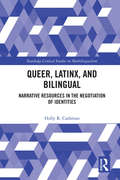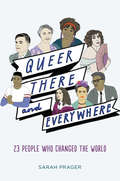- Table View
- List View
Queer Twin Cities
by Michael Franklin Jennifer L. Pierce Patrick Ryan Kevin P. Murphy Jason Ruiz Susan Craddock Twin Cities GLBT Oral History Project Staff Alex T. Urquhart Larry Knopp Charlotte Albrecht Pamela Butler Brandon Lacy CmaposThe Twin Cities is home to one of the largest and most vital GLBT populations in the nation-and one of the highest percentages of gay residents in the country. Drawn from the pioneering work of the Twin Cities GLBT Oral History Project-a collective organization of students, scholars, and activists devoted to documenting and interpreting the lives of GLBT people in Minneapolis and St. Paul-Queer Twin Citiesis a uniquely critical collection of essays on Minnesota's vibrant queer communities, past and present. A rich blend of oral history, archival research, and ethnography,Queer Twin Cities uses sexuality to chart connections between people's lives in Minnesota. Topics range from turn-of-the-century Minneapolis amid moral reform-including the highly publicized William Williams murder trial and efforts to police Bridge Square, aka "skid row"-to northern Minnesota and the importance of male companionship among lumber workers, and to postwar life, when the increased visibility of queer life went hand in hand with increased regulation, repression, and violence. Other essays present a portrait of early queer spaces in the Twin Cities, such as Kirmser's Bar, the Viking Room, and the Persian Palms, and the proliferation of establishments like the Dugout and the 19 Bar. Exploring the activism of GLBT/Two-Spirit indigenous people, the antipornography movements of the 1980s, and the role of gay men in the gentrification of Minneapolis neighborhoods.
Queer Victimology: Understanding the Victim Experience
by Shelly Clevenger Shamika Kelley Kathleen RatajczakThis book provides a much-needed focus on the victimization experiences of those within the lesbian, gay, bisexual, transgender, Queer, intersex, or asexual (LGBTQIA) communities. With original research and scholarly work relating to victimization, supplemented by stories and poems detailing firsthand accounts by people in LGBTQIA communities, the volume editors shine a light on the experiences of those who have been harmed or who have suffered because of who they are. Allowing the reader to gain a deeper understanding of Queer victimization and LGBTQIA victims, the volume delves into how and why people are victimized, as well as how the criminal justice system and other social services interact with victims and each other. The creative pieces included give a direct voice to those who have most often been silenced in the past. Queer Victimology is essential reading for scholars and students in the areas of criminology, victimology, sociology, gender studies, education, counseling, and/or psychology as well as anyone engaged with Queer, critical, and feminist criminologies, gender studies, diversity, and criminal justice.
Queer Victimology: Understanding the Victim Experience
by Shelly Clevenger Shamika Kelley Kathleen RatajczakThis book provides a much-needed focus on the victimization experiences of those within the lesbian, gay, bisexual, transgender, Queer, intersex, or asexual (LGBTQIA) communities. With original research and scholarly work relating to victimization, supplemented by stories and poems detailing firsthand accounts by people in LGBTQIA communities, the volume editors shine a light on the experiences of those who have been harmed or who have suffered because of who they are. Allowing the reader to gain a deeper understanding of Queer victimization and LGBTQIA victims, the volume delves into how and why people are victimized, as well as how the criminal justice system and other social services interact with victims and each other. The creative pieces included give a direct voice to those who have most often been silenced in the past.Queer Victimology is essential reading for scholars and students in the areas of criminology, victimology, sociology, gender studies, education, counseling, and/or psychology as well as anyone engaged with Queer, critical, and feminist criminologies, gender studies, diversity, and criminal justice.
Queer Victorian Families: Curious Relations in Literature (Routledge Studies in Nineteenth Century Literature)
by Duc Dau Shale PrestonThe Victorians elevated the home and heteronormative family life to an almost secular religion. Yet alongside the middle-class domestic ideal were other families, many of which existed in the literature of the time. Queer Victorian Families: Curious Relations in Literature is chiefly concerned with these atypical or "queer" families. This collection serves as a corrective against limited definitions of family and is a timely addition to Victorian studies. Interdisciplinary in nature, the collection opens up new possibilities for uncovering submerged, marginalized, and alternative stories in Victorian literature. Broad in scope, subjects range from Count Fosco and his animal "children" in Wilkie Collins’s The Woman in White, to male kinship within and across Alfred Tennyson’s In Memoriam and Herman Melville’s Moby-Dick, and the nexus between disability and loving relationships in the fiction of Dinah Mulock Craik and Charlotte M. Yonge. Queer Victorian Families is a wide-ranging and theoretically adventurous exposé of the curious relations in the literary family tree.
Queer Vietnam: A History of Gender Transgression, 1920–1945
by Richard Quang-Anh TranQueer Vietnam recovers the forgotten stories of variant genders and sexualities in early twentieth-century Vietnam. By the beginning of the 1900s, European imperialism had spread Western notions of gender across much of Asia, narrowing and delegitimizing what had been a wide range of acceptable gender practices. But in Vietnam, Western influence on gender remained uneven at best. Through archival research and innovative readings of literary sources, Richard Quang-Anh Tran argues that Vietnamese culture embraced a much less rigid view of the human body, and that a far more capacious vision of gendered personhood existed in this period than has been previously assumed. Popular love stories involved cross-dressing monks and traditional women who don male garb to fight in battle. And accounts of proto-lesbian friendships and a futuristic human civilization populated by a higher form of hermaphroditic species all found avid readers. Together, this material reveals that in Vietnam's interwar period, "tradition" coexisted with and jostled against the modern. While current perceptions of Vietnamese history rest on the exclusion of the "queer"—subjects who depart from heteronormative ways of being—this book brings them to the center, and opens up new directions for both the historical study of gender and Vietnam's modernity.
Queer Villains of Myth and Legend
by Dan JonesEvery good hero needs a villain! Explore the hidden world of magnetic and mysterious villains, often cast aside and misunderstood in tales of mythology and folklore. Through the pages of Queer Villains of Myth and Legend, discover a diverse community of fascinating characters, ranging from seductive and cunning to powerful and awe-inspiring.Experience the dark allure of Circe and Medusa through to David Bowie's Jareth in Labyrinth and delve into their complex and multifaceted personalities and motivations. Take a deep dive into the intersection of queerness and villainy, re-examine some of our favourite characters, and discover why so many 'bad' characters are queer-coded. From ancient mythology to contemporary pop culture, Queer Villains of Myth and Legend celebrates the fascinating stories of these often-overlooked characters. Join Dan Jones on a journey of discovery, as he explores the hidden depths of queer villainy and sheds light on the queer identities of these compelling figures. It's a powerful celebration of queerness through the ages in all its legendary complexity.
Queer Villains of Myth and Legend
by Dan JonesEvery good hero needs a villain! Explore the hidden world of magnetic and mysterious villains, often cast aside and misunderstood in tales of mythology and folklore. Through the pages of Queer Villains of Myth and Legend, discover a diverse community of fascinating characters, ranging from seductive and cunning to powerful and awe-inspiring.Experience the dark allure of Circe and Medusa through to David Bowie's Jareth in Labyrinth and delve into their complex and multifaceted personalities and motivations. Take a deep dive into the intersection of queerness and villainy, re-examine some of our favourite characters, and discover why so many 'bad' characters are queer-coded. From ancient mythology to contemporary pop culture, Queer Villains of Myth and Legend celebrates the fascinating stories of these often-overlooked characters. Join Dan Jones on a journey of discovery, as he explores the hidden depths of queer villainy and sheds light on the queer identities of these compelling figures. It's a powerful celebration of queerness through the ages in all its legendary complexity.
Queer Villains of Myth and Legend
by Dan JonesHidden in the margins of history books, classical literature, and thousands of years of stories, myths and legends, through to contemporary literature, TV and film, there is a diverse and other-worldly super community of queer heroes to discover, learn from, and celebrate. Be captivated by stories of forbidden love like Patroclus & Achilles (explored in Madeleine Miller's bestseller Song of Achilles), join the cult of Antinous (inspiration for Oscar Wilde), get down with pansexual god Set in Egyptian myth, and fall for Zimbabwe's trans God Mawi. And from modern pop-culture, through Dan Jones's witty, upbeat style, learn more about 90s fan obsessions Xena: Warrior Princess and Buffy the Vampire Slayer, Neil Gaiman's American Gods and the BBC's Doctor Who. Queer Heroes of Myth & Legend brings to life characters who are romantic, brave, mysterious, and always fantastical. It is a magnificent celebration of queerness through the ages in all its legendary glory.(p) 2023 Octopus Publishing Group
Queer Virtue: What LGBTQ People Know About Life and Love and How It Can Revitalize Christianity
by Rev Elizabeth M. EdmanLGBTQ people are a gift to the Church and have the potential to revitalize Christianity.As an openly lesbian Episcopal priest and professional advocate for LGBTQ justice, the Reverend Elizabeth Edman has spent her career grappling with the core tenets of her faith. After deep reflection on her tradition, Edman is struck by the realization that her queer identity has taught her more about how to be a good Christian than the church.In Queer Virtue, Edman posits that Christianity, at its scriptural core, incessantly challenges its adherents to rupture false binaries, to "queer" lines that pit people against one another. Thus, Edman asserts that Christianity, far from being hostile to queer people, is itself inherently queer. Arguing from the heart of scripture, she reveals how queering Christianity--that is, disrupting simplistic ways of thinking about self and other--can illuminate contemporary Christian faith. Pushing well past the notion that "Christian love = tolerance," Edman offers a bold alternative: the recognition that queer people can help Christians better understand their fundamental calling and the creation of sacred space where LGBTQ Christians are seen as gifts to the church.By bringing queer ethics and Christian theology into conversation, Edman also shows how the realities of queer life demand a lived response of high moral caliber--one that resonates with the ethical path laid down by Christianity. Lively and impassioned, Edman proposes that queer experience be celebrated as inherently valuable, ethically virtuous, and illuminating the sacred.A rich and nuanced exploration, Queer Virtue mines the depths of Christianity's history, mission, and core theological premises to call all Christians to a more authentic and robust understanding of their faith.
Queer Voices
by Freya Jarman-IvensThis book argues that there are some important implications of the role the voice plays in popular music when thinking about processes of identification. The central thesis is that the voice in popular music is potentially uncanny (Freud's unheimlich), and that this may invite or guard against identification by the listener.
Queer Voices in Post-War Scotland: Male Homosexuality, Religion And Society (Genders And Sexualities In History)
by Jeffrey MeekThis book examines the experiences of gay and bisexual men who lived in Scotland during an era when all homosexual acts were illegal, tracing the historical relationship between Scottish society, the state and its male homosexual population using a combination of oral history and extensive archival research.
Queer Women in Modern Spanish Literature: Activism, Sexuality, and the Otherness of the 'Chicas Raras' (Literary Criticism and Cultural Theory)
by Ana I. Simón-Alegre and Lou Charnon-DeutschThis original collection of essays explores the work and life choices of Spanish women who, through their writings and social activism, addressed social justice, religious dogmatism, the educational system, gender inequality, and tensions in female subjectivity. It brings together writers who are not commonly associated with each other, but whose voices overlap, allowing us to foreground their unconventionality, their relationships to each other, and their relation to modernity. The objective of this volume is to explore how the idea of "queerness" played an important role in the personal lives and social activism of these writers, as well as in the unconventional and nonconformist characters they created in their work. Together, the essays demonstrate that the concept of "queer women" is useful for investigating the evolution of women’s writing and sexual identity during the period of Spain’s fitful transition to modernity in the nineteenth century. The concept of queerness in its many meanings points to the idea of non-normativity and gender dissidence that encompasses how women intellectuals experienced friendship, religion, sex, sexuality, and gender. The works examined include autobiography, poetry, memoir, salon chronicles, short and long fiction, pedagogical essays, newspaper articles, theater, and letters. In addition to exploring the significant presence of queer women in nineteenth- and twentieth-century Spanish literature and culture, the essays examine the reasons why the voices of Spanish women authors have been culturally silenced. One thrust in this collection explores generational transitions of Spanish writers from the romantics and their "hermandad lírica" ("lyrical sisterhood") through to "las Sinsombrero" ("Women Without Hats"), and finally, current Spanish writers linked to the LGBTQ+ community.
Queer Women in Urban China: An Ethnography (Routledge Research in Gender and Society #37)
by Elisabeth L. EngebretsenLala (lesbian) and gay communities in mainland China have emerged rapidly in the 21st century. Alongside new freedoms and modernizing reforms, and with mainstream media and society increasingly tolerant, lalas still experience immense family and social pressures to a degree that this book argues is deeply gendered. The first anthropological study to examine everyday lala lives, intimacies, and communities in China, the chapters explore changing articulations of sexual subjectivity, gendered T-P (tomboy-wife) roles, family and kinship, same-sex weddings, lala-gay contract marriages, and community activism. Engebretsen analyzes lala strategies of complicit transgressions to balance surface respectability and undeclared same-sex desires, why "being normal" emerges a deep aspiration and sign of respectability, and why openly lived homosexuality and public activism often are not. Queer Women in Urban China develops a critical ethnographic analysis through the conceptual lens of "different normativities," tracing the paradoxes and intricacies of the desire for normal life alongside aspirations for recognition, equality, and freedom, and argues that dominant paradigms fixed on categories, identities, and the absolute value of public visibility are ill-equipped to fully understand these complexities. This book complements existing perspectives on sexual and gender diversity, contemporary China, and the politics and theories of justice, recognition, and similitude in global times.
Queer Words, Queer Images: Communication and the Construction of Homosexuality
by R. Jeffrey Ringer Cara ShoresIn many arenas the debate is raging over the nature of sexual orientation. Queer Words, Queer Images addresses this debate, but with a difference, arguing that homosexuality has become an issue precisely because of the way in which we discuss, debate, and communicate about the concept and experience of homosexuality. The debate over homosexuality is fundamentally an issue of communication-as we can see by the recent controversy over gays in the military. This controversy, termed by one gay man as the annoying habit of heterosexual men to overestimate their own attractiveness, has been debated in communication-sensitive terms, such as morale and discipline. The twenty chapters address such subjects as gay political language, homosexuality and AIDS on prime-time television, the politics of male homosexuality in young adult fiction, the identification of female athleticism with lesbianism, the politics of identity in the works of Edmund White, and coming out strategies. This is must reading for students of communication practices and theory, and for everyone interested in human sexuality. Contributing to the book are: James Chesebro (Indiana State), James Darsey (Ohio State), Joseph A. Devito (Hunter College, CUNY), Timothy Edgar (Purdue), Mary Anne Fitzpatrick (Wisconsin, Madison), Karen A. Foss (Humboldt State), Kirk Fuoss (St. Lawrence), Larry Gross (Pennsylvania), Darlene Hantzis (Indiana State), Fred E. Jandt (California State, San Bernardino), Mercilee Jenkins (San Francisco State), Valerie Lehr (St. Lawrence), Lynn C. Miller (Texas, Austin), Marguerite Moritz (Colorado, Boulder), Fred L. Myrick (Spring Hill), Emile Netzhammer (Buffalo State), Elenie Opffer, Dorothy S. Painter (Ohio State), Karen Peper (Michigan), Nicholas F. Radel (Furman), R. Jeffrey Ringer (St. Cloud State), Scott Shamp (Georgia), Paul Siegel (Gallaudet), Jacqueline Taylor (Depaul), Julia T. Wood (North Carolina, Chapel Hill).
Queer Words, Queer Images: Communication and the Construction of Homosexuality (Open Access Lib And Hc Ser.)
by R. Jeffrey Ringer Cara ShoresIn many arenas the debate is raging over the nature of sexual orientation. Queer Words, Queer Images addresses this debate, but with a difference, arguing that homosexuality has become an issue precisely because of the way in which we discuss, debate, and communicate about the concept and experience of homosexuality. The debate over homosexuality is fundamentally an issue of communication—as we can see by the recent controversy over gays in the military. This controversy, termed by one gay man as the annoying habit of heterosexual men to overestimate their own attractiveness, has been debated in communication-sensitive terms, such as morale and discipline. The twenty chapters address such subjects as gay political language, homosexuality and AIDS on prime-time television, the politics of male homosexuality in young adult fiction, the identification of female athleticism with lesbianism, the politics of identity in the works of Edmund White, and coming out strategies. This is must reading for students of communication practices and theory, and for everyone interested in human sexuality. Contributing to the book are: James Chesebro (Indiana State), James Darsey (Ohio State), Joseph A. Devito (Hunter College, CUNY), Timothy Edgar (Purdue), Mary Anne Fitzpatrick (Wisconsin, Madison), Karen A. Foss (Humboldt State), Kirk Fuoss (St. Lawrence), Larry Gross (Pennsylvania), Darlene Hantzis (Indiana State), Fred E. Jandt (California State, San Bernardino), Mercilee Jenkins (San Francisco State), Valerie Lehr (St. Lawrence), Lynn C. Miller (Texas, Austin), Marguerite Moritz (Colorado, Boulder), Fred L. Myrick (Spring Hill), Emile Netzhammer (Buffalo State), Elenie Opffer, Dorothy S. Painter (Ohio State), Karen Peper (Michigan), Nicholas F. Radel (Furman), R. Jeffrey Ringer (St. Cloud State), Scott Shamp (Georgia), Paul Siegel (Gallaudet), Jacqueline Taylor (Depaul), Julia T. Wood (North Carolina, Chapel Hill).
Queer Youth, Suicide and Self-Harm: Troubled Subjects, Troubling Norms
by Elizabeth McDermott Katrina RoenOffering a new way of understanding the high self-harm and suicide rates among sexual and gender minority youth, this book prioritises the perspectives and experiences of queer young people, including those who have experience of self-harming and/or feeling suicidal. Presenting analysis based on research carried out with young people both online and face-to-face, the authors offer a critical perspective on the role of norms, namely developmental norms, gender and sexuality norms, and neoliberal norms, in the production of self-harming and suicidal youth. Queer Youth, Suicide and Self-Harm is unique in the way it works at the intersection of class and sexuality, and in its specific focus on transgender youth and the concept of embodied distress. It also examines the implications of this research for self-harm reduction and suicide prevention.
Queer and Catholic
by Trebor Healey Amie EvansHow does one reconcile the tension between the community of one’s own Catholic upbringing and a sexuality and gender identity that may be in conflict with some of the tenets of the faith – especially when one is a member of the Gay, Lesbian, Bisexual, Transgender, Queer, and Intersex community? Queer and Catholic offers a source of comfort to members of these communities, focusing on not only practicing Catholics, but also the entire experience of growing up Catholic. This unique book discusses Catholicism beyond its religiosity and considers its implications as a culture of origin. This widely varied and entertaining book pulls together a comprehensive collection of essays, stories, and poetry that together represent an honest and engaging reflection of being a queer person within the Catholic experience.
Queer and Loathing: Rants and Raves of a Raging AIDS Clone
by Tony Kushner David B. Feinberg"This is as close to the truth as I can get, " writes David B. Feinberg in this stunning nonfiction debut - a collection of autobiographical essays, gonzo journalism, and demented Feinbergian lists about AIDS activism and living, writing, and dying with AIDS. With the startling blend of satiric wit and pathos, black humor and heroism, found in his widely acclaimed and iconoclastic novels, he charts a harrowing personal journey down that "HIV highway to hell."
Queer and Trans Migrations: Dynamics of Illegalization, Detention, and Deportation (Dissident Feminisms)
by Monisha Das Gupta Ryan Conrad Karma R. Chavez Andrew J. Brown Anna Carastathis Myrto Tsilimpounidi Julio Capo Jack Caraves Elif Katherine Fobear Jamila Hammami Edward Ou Lee Leece Lee-Oliver Eithne Luibheid Hana Masri Yasmin Nair Bamby Salcedo Fadi Saleh Rafael Ramirez Solorzano José Guadalupe Soto Suyapa Portillo Villeda Sasha Wijeyeratne Ruben ZecenaMore than a quarter of a million LGBTQ-identified migrants in the United States lack documentation and constantly risk detention and deportation. LGBTQ migrants around the world endure similarly precarious situations. Eithne Luibhéid's and Karma R. Chávez’s edited collection provides a first-of-its-kind look at LGBTQ migrants and communities. The academics, activists, and artists in the volume center illegalization, detention, and deportation in national and transnational contexts, and examine how migrants and allies negotiate, resist, refuse, and critique these processes. The works contribute to the fields of gender and sexuality studies, critical race and ethnic studies, borders and migration studies, and decolonial studies. Bridging voices and works from inside and outside of the academy, and international in scope, Queer and Trans Migrations illuminates new perspectives in the field of queer and trans migration studies. Contributors: Andrew J. Brown, Julio Capó, Jr., Anna Carastathis, Jack Cáraves, Karma R. Chávez, Ryan Conrad, Elif, Katherine Fobear, Monisha Das Gupta, Jamila Hammami, Edward Ou Jin Lee, Leece Lee-Oliver, Eithne Luibhéid, Hana Masri, Yasmin Nair, Bamby Salcedo, Fadi Saleh, Rafael Ramirez Solórzano, José Guadalupe Herrera Soto, Myrto Tsilimpounidi, Suyapa Portillo Villeda, Sasha Wijeyeratne, Ruben Zecena
Queer as Camp: Essays on Summer, Style, and Sexuality
by Kenneth B. Kidd Derritt MasonNamed the #1 Bestselling Non-Fiction Title by the Calgary HeraldTo camp means to occupy a place and/or time provisionally or under special circumstances. To camp can also mean to queer. And for many children and young adults, summer camp is a formative experience mixed with homosocial structure and homoerotic longing. In Queer as Camp, editors Kenneth B. Kidd and Derritt Mason curate a collection of essays and critical memoirs exploring the intersections of “queer” and “camp,” focusing especially on camp as an alternative and potentially nonnormative place and/or time. Exploring questions of identity, desire, and social formation, Queer as Camp delves into the diverse and queer-enabling dimensions of particular camp/sites, from traditional iterations of camp to camp-like ventures, literary and filmic texts about camp across a range of genres (fantasy, horror, realistic fiction, graphic novels), as well as the notorious appropriation of Indigenous life and the consequences of “playing Indian.” These accessible, engaging essays examine, variously, camp as a queer place and/or the experiences of queers at camp, including Vermont’s Indian Brook, a single-sex girls’ camp that has struggled with the inclusion of nonbinary and transgender campers and staff; the role of Jewish summer camp as a complicated site of sexuality, social bonding, and citizen-making as well as a potentially if not routinely queer-affirming place. They also attend to cinematic and literary representations of camp, such as the Eisner award-winning comic series Lumberjanes, which revitalizes and revises the century-old Girl Scout story; Disney’s Paul Bunyan, a short film that plays up male homosociality and cross-species bonding while inviting queer identification in the process; Sleepaway Camp, a horror film that exposes and deconstructs anxieties about the gendered body; and Wes Anderson’s critically acclaimed Moonrise Kingdom, which evokes dreams of escape, transformation, and other ways of being in the world. Highly interdisciplinary in scope, Queer as Camp reflects on camp and Camp with candor, insight, and often humor. Contributors: Kyle Eveleth, D. Gilson, Charlie Hailey, Ana M. Jimenez-Moreno, Kathryn R. Kent, Mark Lipton, Kerry Mallan, Chris McGee, Roderick McGillis, Tammy Mielke, Alexis Mitchell, Flavia Musinsky, Daniel Mallory Ortberg, Annebella Pollen, Andrew J. Trevarrow, Paul Venzo, Joshua Whitehead
Queer in Russia: A Story of Sex, Self, and the Other
by Laurie EssigIn Queer in Russia Laurie Essig examines the formation of gay identity and community in the former Soviet Union. As a sociological fieldworker, she began her research during the late 1980s, before any kind of a public queer identity existed in that country. After a decade of conducting interviews, as well as observing and analyzing plays, books, pop music, and graffiti, Essig presents the first sustained study of how and why there was no Soviet gay community or even gay identity before perestroika and the degree to which this situation has--or has not--changed. While male homosexual acts were criminalized in Russia before 1993, women attracted to women were policed by the medical community, who saw them less as criminals than as diseased persons potentially cured by drug therapy or transsexual surgery. After describing accounts of pre-perestroika persecution, Essig examines the more recent state of sexual identities in Russia. Although the fall of communism brought new freedom to Russian queers, there are still no signs of a mass movement forming around the issue, and few identify themselves as lesbians or gay men, even when they are involved in same-sex relations. Essig does reveal, however, vibrant manifestations of gay life found at the local level--in restaurants, discos, clubs, and cruising strips, in newspapers, journals, literature, and the theater. Concluding with a powerful exploration of the surprising affinities between some of Russia's most prominent nationalists and its queers, Queer in Russia fills a gap in both Russian and cultural studies.
Queer in Translation: Sexual Politics under Neoliberal Islam (Perverse Modernities: A Series Edited by Jack Halberstam and Lisa Lowe)
by Evren SavciIn Queer in Translation, Evren Savcı analyzes the travel and translation of Western LGBT political terminology to Turkey in order to illuminate how sexual politics have unfolded under Recep Tayyip Erdoğan's AKP government. Under the AKP's neoliberal Islamic regime, Savcı shows, there has been a stark shift from a politics of multicultural inclusion to one of securitized authoritarianism. Drawing from ethnographic work with queer activist groups to understand how discourses of sexuality travel and are taken up in political discourse, Savcı traces the intersection of queerness, Islam, and neoliberal governance within new and complex regimes of morality. Savcı turns to translation as a queer methodology to think Islam and neoliberalism together and to evade the limiting binaries of traditional/modern, authentic/colonial, global/local, and East/West—thereby opening up ways of understanding the social movements and political discourse that coalesce around sexual liberation in ways that do justice to the complexities both of what circulates under the signifier Islam and of sexual political movements in Muslim-majority countries.
Queer, 2nd Edition: The Ultimate LGBTQ Guide for Teens
by Kathy Belge Marke BieschkeTeen life is hard enough, but for teens who are LGBTQ, it can be even harder. When do you decide to come out? Will your friends accept you? And how do you meet people to date? Queer is a humorous, engaging, and honest guide that helps LGBTQ teens come out to friends and family, navigate their social life, figure out if a crush is also queer, and challenge bigotry and homophobia. Personal stories from the authors and sidebars on queer history provide relatable context. This completely revised and updated edition is a must-read for any teen who thinks they might be queer or knows someone who is. "A delightful collection of trustworthy and accurate information that tweens and teens need today, all told in a sort of quirky, sometimes goofy, and always approachable tone...a fun, easy to read, and occasionally hilarious guide that should be available on a shelf in every high school library." —Diane Anderson-Minshall, Editorial Director, The Advocate magazine "Not every queer kid has easy access to a family member, teacher, counselor, or friend who can help them through the coming-out process. Even when they do, NEWSFLASH, most of us don't have all the answers! Queer is a great way for a teen, or someone who is trying to mentor or understand a queer teen, to gain some knowledge from a thoughtful, cute perspective."—Honey Mahogany, Activist, RuPaul's Drag Race Alumnus, Cofounder of the Compton's Transgender Cultural District "I learned more than a few things about our fabulously diverse queer culture, and especially the younger generation, that everyone should know."—Terry Beswick, Executive Director of the GLBT Historical Society Archives and Museum
Queer, Latinx, and Bilingual: Narrative Resources in the Negotiation of Identities (Routledge Critical Studies in Multilingualism)
by Holly CashmanShortlisted for the 2018 BAAL Book Prize This book is a sociolinguistic ethnography of LGBT Mexicans/Latinxs in Phoenix, Arizona, a major metropolitan area in the U.S. Southwest. The main focus of the book is to examine participants’ conceptions of their ethnic and sexual identities and how identities influence (and are influenced by) language practices. This book explores the intersubjective construction and negotiation of identities among queer Mexicans/Latinxs, paying attention to how identities are co-constructed in the interview setting in coming out narratives and in narratives of silence. The book destabilizes the dominant narrative on language maintenance and shift in sociolinguistics, much of which relies on a (heterosexual) family-based model of intergenerational language transmission, by bringing those individuals often at the margin of the family (LGBTQ members) to the center of the analysis. It contributes to the queering of bilingualism and Spanish in the U.S., not only by including a previously unstudied subgroup (LGBTQ people), but also by providing a different lens through which to view the diverse language and identity practices of U.S. Mexicans/Latinxs. This book addresses this exclusion and makes a significant contribution to the study of bilingualism and multilingualism by bringing LGBTQ Latinas/os to the center of the analysis.
Queer, There, and Everywhere: 23 People Who Changed the World
by Sarah Prager Zoe More O'FerrallThis first-ever LGBTQ history book of its kind for young adults will appeal to fans of fun, empowering pop-culture books like Rad American Women A-Z and Notorious RBG.World history has been made by countless lesbian, gay, bisexual, transgender, and queer individuals—and you’ve never heard of many of them. Queer author and activist Sarah Prager delves deep into the lives of 23 people who fought, created, and loved on their own terms. From high-profile figures like Abraham Lincoln and Eleanor Roosevelt to the trailblazing gender-ambiguous Queen of Sweden and a bisexual blues singer who didn’t make it into your history books, these astonishing true stories uncover a rich queer heritage that encompasses every culture, in every era. By turns hilarious and inspiring, the beautifully illustrated Queer, There, and Everywhere is for anyone who wants the real story of the queer rights movement.A Junior Library Guild Selection
